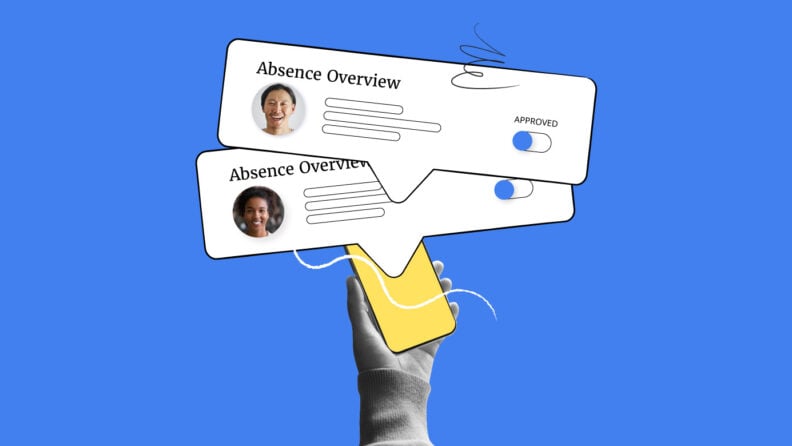Managing employee leave is a critical yet often overlooked aspect of running a successful organization.
Whether it’s planned vacations, unexpected sick days, or statutory leaves, effectively handling time off is essential for maintaining operational efficiency, worker satisfaction, and legal compliance.
Leave management isn’t just about tracking days off; it’s about creating a framework that supports both the organization’s goals and the well-being of its workforce.
Yet, despite its significance, leave management presents several challenges for businesses. These include handling overlapping leave requests, ensuring fairness, staying updated on legal requirements, and integrating leave policies with overall workforce planning.
In today’s hybrid and remote work setups, tracking and managing leave has become even more complex.
Here I’ll explore the fundamentals of leave management, common obstacles organizations face, and practical strategies to overcome them, ensuring a complete process that benefits both employees and employers.
What Is Leave Management?
Leave management is the process of managing employee time off from work, including vacation days, sick leave, parental leave, and other types of absences.
It involves tracking leave requests, approving or denying them, ensuring compliance with labor laws, and maintaining sufficient workforce coverage to minimize disruptions to business operations.
Effective leave management is a tricky balancing act, even for the most experienced HR professionals.
As a leave manager, you are tasked with juggling the following responsibilities:
- Time off tracking
- Legal compliance
- Policy creation and enforcement
- Workforce management
- Reporting and analytics
- Recordkeeping
- Employee education and support.
8 Benefits Of Effective Leave Management
Leave management impacts all aspects of business as well as employee wellbeing. An effective leave management program benefits organizations in the following ways:
- Operational efficiency: Ensures sufficient staff coverage to maintain productivity and meet business goals, even during peak leave periods.
- Legal compliance: Reduces the risk of penalties by adhering to labor laws and regulations regarding employee leave entitlements.
- Cost management: Prevents unnecessary costs caused by mismanagement, such as unplanned overtime or hiring temporary staff.
- Data insights: Provides insights into leave trends, helping in workforce planning and identifying potential issues like high absenteeism.
- Fairness and transparency: Creates trust by applying consistent and equitable leave policies.
- Employee well-being: Encourages employees to take necessary breaks, reducing burnout and stress and helping create a healthier, happier, more productive workforce.
- Morale and satisfaction: Fosters a positive workplace culture where employees feel supported in managing personal and professional responsibilities.
- Reputation boost: Can demonstrate the organization’s commitment to employee well-being, enhancing employer branding and talent attraction.
6 Leave Management Challenges
Leave management can present several challenges for organizations, particularly as workforces become more diverse and operational demands fluctuate. Here are some common issues:
- Tracking time off and leave: Improperly tracked time off and leave date can cause a ripple effect on different functions, for example payroll errors, inequity, lack of business coverage, and compliance risk.
- Coverage planning: Juggling multiple absence requests, especially within a team or department, can be complex and happens quite often. If all requests are approved without review, for example, it can ensure a team is working under capacity resulting in performance impacts.
- Compliance with labor laws: Staying updated on local, national, and international leave regulations can be challenging, particularly for global organizations.
- Fairness and bias: Ensuring equitable access to leave can be difficult, especially when managers have discretion over approvals that can potentially lead to perceptions of favoritism.
- System integration: Integrating leave management systems with payroll, attendance, and workforce planning systems can be complex, especially if the organization uses outdated or incompatible tools.
- Cultural differences: In global organizations, cultural norms around leave can vary, requiring sensitivity and adaptability in policy design.
5 Leave Management Best Practices
In my experience, implementing these best practices will help you overcome the above challenges and significantly enhance efficiency, compliance, and employee satisfaction.
1. Establish transparent leave policies
Building transparency in your policy can be done through the use of clear and actionable information.
We can all agree that most HR policies are a dry read, but they don’t need to be so complicated.
Drafting effective policies is similar to building a puzzle. To help you get started, I’ve compiled all the puzzle pieces you need to build a complete leave policy.
- Absence type—self-explanatory, defines the absence covered in the policy, i.e. bereavement leave, parental leave, etc.
- Eligibility criteria—establishes minimum requirements to be met by employees in order to be allowed to request this absence type.
- Qualifying reasons—establishes covered reasons employees may use the absence type.
- Requests process—outlines what actions employees need to take to request time away from work.
- Notice requirement—establishes the minimum amount of notice the employer needs to ensure business coverage.
- Pay and benefits—establishes if employees are eligible for payment under the absence type and how payroll will be processed as well as benefits continuation information and deduction processing.
- Job protection—establishes if the absence type is protected time under federal/state/local law and defines protections as well as a process of reinstatement upon an employee's return from leave.
- Return to work—outlines what actions employees need to take prior to the scheduled return to work. Oftentimes this is providing a fitness for duty form.
Remember, as you’re drafting your leave policy, it's crucial you ensure it aligns with any federal, state, or local laws establishing leave requirements.
While employers must adhere to minimum leave entitlements, they can go above and beyond them at their discretion.
Your policies are a reflection of your company culture, for example Netflix’s famous unlimited PTO policy, and should be updated over time based on data, feedback, and regulatatory changes.
2. Communicate, communicate, communicate
Leave policies are often not top of mind for employees until the need for time off arises, so make it easy for people to adhere to policy guidelines by communicating them effectively.
Some steps you should take to efficiently communicate a new leave policy to your population include:
- Sending an initial company widespread email that highlights the following:
- The effective date of the policy
- The objective of the policy
- A link to the policy documents and additional resources for further review
- Any action required on behalf of your population
- And any applicable information/education session dates
- Host an education session to present the policy and answer employee questions
- Host 1 on 1 office hours in case employees want to meet confidentially to discuss their questions/concerns
- Ensure policies and resources are posted in a centralized location, such as the company intranet, and highly office populated areas such as a break room.
Communication doesn’t stop with new policies, ongoing communication is key to ensuring employees stay compliant with policy guidelines.
While a widespread company email may not be needed, yearly employee handbook acknowledgments or annual education sessions can serve as a great reminder on the policies and procedures in place that guide the employee absence requests process.
You can also use policy management software to help you track how often the policy is referenced and set up automated reminders to send out periodically.
3. Monitor regulatory leave requirements
Ongoing monitoring of regulatory leave requirements is essential to ensuring compliance with federal, state, and local laws.
While it is not customary for federal mandates to change often, unless in the event of a global emergency, state and local laws can vary and require more attention and should be reviewed to ensure policies are updated as needed.
Some good resources you can always rely on are:
- The official U.S. Department of Labor website
- Official state and municipal websites.
When a new law comes into effect, or a current law is revised, an official communication will be posted on these platforms and resources for companies and workers will be made available to ensure covered employers take action in accordance with applicable requirements and workers are notified of any rights under these new laws.
Also important to note is that most leave management software vendors offer regulatory compliance monitoring to ensure your policies stay in compliance with the law while also saving you team time scouring the internet for updates.
4. Leverage technology
Leave management software helps organizations to oversee and manage all leave management functions in a centralized platform.
Through the use of this technology, the need for manual processes becomes obsolete, which in turn reduces human error while also saving your team time managing absence requests.
Leave management systems helps HR professionals to more easily:
- Configure company absence types into the system that align with mandated regulations and company policy
- Track and process employee time off requests
- Calculate accruals and leave balances
- Set up important notifications and reminders
- Integrate state disability benefits
- Manage payroll adjustments
- Securely store important documents
- Run reporting
- Adhere to regulatory changes.
Additionally, workers will have access to a user-friendly one stop shop where they can easily request a need for absence within minutes, get real time updates as their requests are being processed, easily upload documents, and utilize interactive tools to learn more about available leave programs and review the linked company policies.
By leveraging leave management technology, organizations are able to streamline the leave management process and ultimately optimize the employee experience.
10 Best Leave Management Software Shortlist
Here's my pick of the 10 best software from the 10 tools reviewed.
5. Train managers and educate employees
Team members will often notify their manager of a need for leave or time off requests before reaching out to the HR business partner.
Since managers play a vital role as the first line of support for employees, they must be versed on basic mandated leave entitlements, leave policies and approval processes in place to guide employees.
This will mitigate misinformation and ultimately lessen compliance risks for the organization while ensuring employees feel supported by the business.
While time off is certainly more self-explanatory, leaves can be a more nuanced topic to digest.
Employees with a need for leave are already navigating extenuating life circumstances. Proper leave education can ensure employees understand their rights and responsibilities under applicable leave laws and absence eligibility to make informed decisions while also ensuring they follow due process aligning with company policy.
Subscribe To The People Managing People Newsletter
Leave management can be complex for HR professionals and employees alike.
I hope this article has helped prepare you with the right processes and tools to be able to design an effective leave management strategy and educate employees.
For any further help or guidance on leave management and talent management in general, subscribe to our weekly newsletter for HR and business leaders. You’ll receive all our latest content to help you advance in your career and make greater impact in your org.
Leave Management FAQs
What leave types do I need to be aware of?
While the terms “leave” and “time off” are used interchangeably, it’s important to note the difference between a leave of absence and time off.
Time off policies provide employees with access to time away from work for everyday circumstances, while leave of absence policies grant employees time away for extended periods of time to deal with extenuating life circumstances.
Time off and leave of absence are categorized by two types, Mandatory and Voluntary.
Mandatory time off and leave of absence programs are regulated by federal, state, and local laws and provide employees with job-protected time away from work.
For example, the Family Medical Leave Act (FMLA), provides eligible or covered employers with unpaid job-protected leave for qualifying family and medical reasons as well as reasons related to Military service.
It’s the employer’s responsibility to communicate any time off or leave entitlements to employees while making sure they have access when eligible to the protected time.
Voluntary time off and leave of absence programs are considered employee perks.These policies are created at the employer’s discretion.
Some popular examples include:
- Vacation/Paid Time Off (PTO)
- Sick Time Off
- Public Holidays
- Volunteer Time Off (VTO)
- Sabbaticals
- Bereavement Leave
- Parental Leave
Oftentimes, mandatory and voluntary leave policies will coincide. Employers can create voluntary leaves that work to expand mandatory leave entitlements for their employee population as long as they don’t lessen any leave entitlements provided by other mandatory leaves.
What federal holidays are there in the US?
The United States has several public (federal) holidays that are widely recognized, though private employers are not legally required to observe them. These are the most common U.S. public holidays:
- New Year’s Day – January 1
- Martin Luther King Jr. Day – Third Monday in January
- Presidents’ Day (Washington’s Birthday) – Third Monday in February
- Memorial Day – Last Monday in May
- Independence Day – July 4
- Labor Day – First Monday in September
- Columbus Day (or Indigenous Peoples’ Day) – Second Monday in October (varies by state)
- Veterans Day – November 11
- Thanksgiving Day – Fourth Thursday in November
- Christmas Day – December 25




